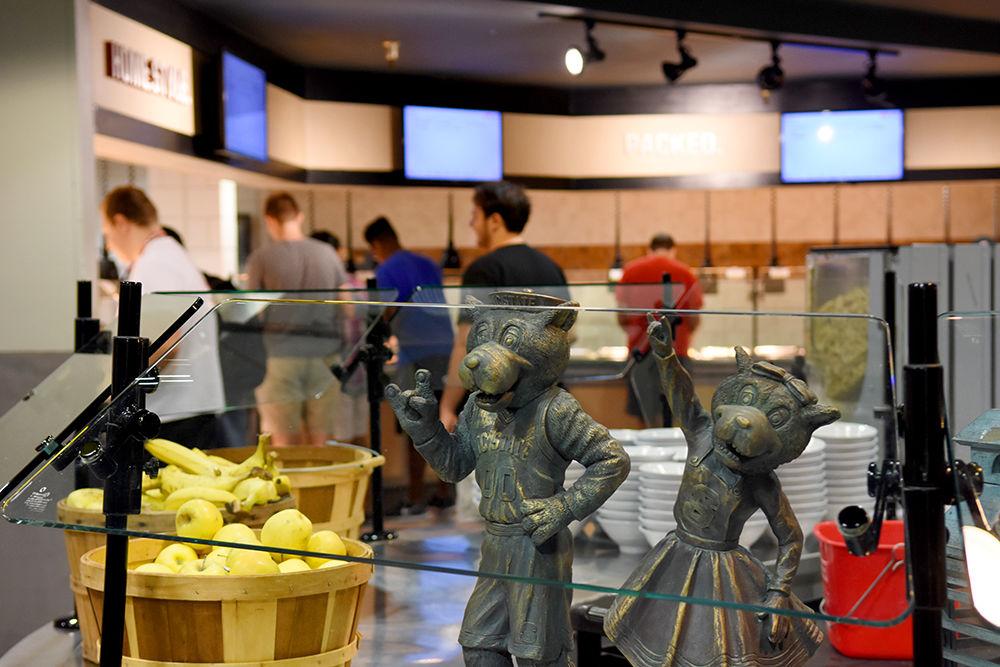As students are coming back from summer break, many are noticing renovations made to Fountain Dining Hall over the summer. The renovations include changes to both the food and decor, and students can expect more improvements to come in the near future as part of NC State Dining’s plan to better serve students.
The renovations include new food stations, such as a panini and a saute station, new dining utensils and plates, new satellite TVs, decor changes and an expansion of the drink selection.
The purpose of the changes to Fountain Dining Hall and of the new meal plans is to make the dining halls more accessible to students as study spaces and hang-out locations.
The stations will be providing a new variety of food choices to students, an improvement on previous years when each station served the same selection of food.
Keith Smith, the director of board operations and sustainability for NC State Dining, explained that the old way of doing things was called “the scramble technique.”
“The way we were serving food is called the old scramble technique, which is you basically set up a lot of the same food lines and it allowed a lot of people to get food fast,” Smith said.
This added variety is part of a larger plan by NC State Dining to focus more on health and dietary constraints.
Fountain Dining hall also now uses white square plates instead of the former round, dark-colored plates. Students like Eric Compton, a third-year studying science, technology, and society, are noticing.
“I like what they’ve done with the plates, it makes it look more modern,” Compton said.
New TVs with satellite programming and new channels also have been installed in the dining hall. The new channels include ESPN, according to Fountain Dining Hall Manager Crayton Garrell.
A combination of carpeting and updated grey tiles replaced the dining hall’s fluorescent orange tile flooring.
The changes at Fountain Dining Hall are creating a friendlier environment, according to Randy Lait, senior director of hospitality services. Lait said that the changes at Fountain Dining Hall are just one piece of a broader plan to make dining halls a bigger part of the NC State community.
“I think the dining halls will be a place where people can hang out more and get together more, and I think that’s a good thing,” Lait said.
The recent change in dining plans is also a part of this plan. Three of the meal plans now include an all-access pass to the dining halls.
“In the past, we had these options of 10, 12 or 14 meals a week, and it meant that students had to budget,” Lait said.
With the new dining plans, students are free to go to the dining halls to eat, snack, study or just hang out whenever dining halls are open. Students just have to wait 30 minutes between visits to dining halls.
Plans are currently underway to add a soft seating area to Fountain Dining Hall, which will include a couch and love seats, specifically for students to hang out.
The changes are part of Lait’s mission to take dining at NC State from “good to great” and his commitment to listening to student feedback.
“All of this started last year, when we had students interested in more fresh fruits, so we started upgrading the fruit bars, and there were some other things we did starting last year,” Lait said.
From there, Fountain Dining Hall was upgraded, and plans are now in place to expand Case Dining Hall from 140 occupants to 200 occupants next summer.
A new focus has also been put on the quality and types of food served. Today, 26 professional chefs work for NC State Dining and are responsible for creating and updating recipes, compared to only one professional chef a few years ago.
NC State is also engaging with the trend of preparing locally-grown foods, and 26 percent of the food served is locally grown, according to Smith.
As a part of this new commitment, NC State Dining is partnering with the College of Agriculture and Life Sciences to raise produce in a sustainable way for all of NC State’s dining options.
“I know Fountain is very old, so it’s cool to have a new modern take on everything,” said Troy Edwards, a second-year studying industrial engineering.








